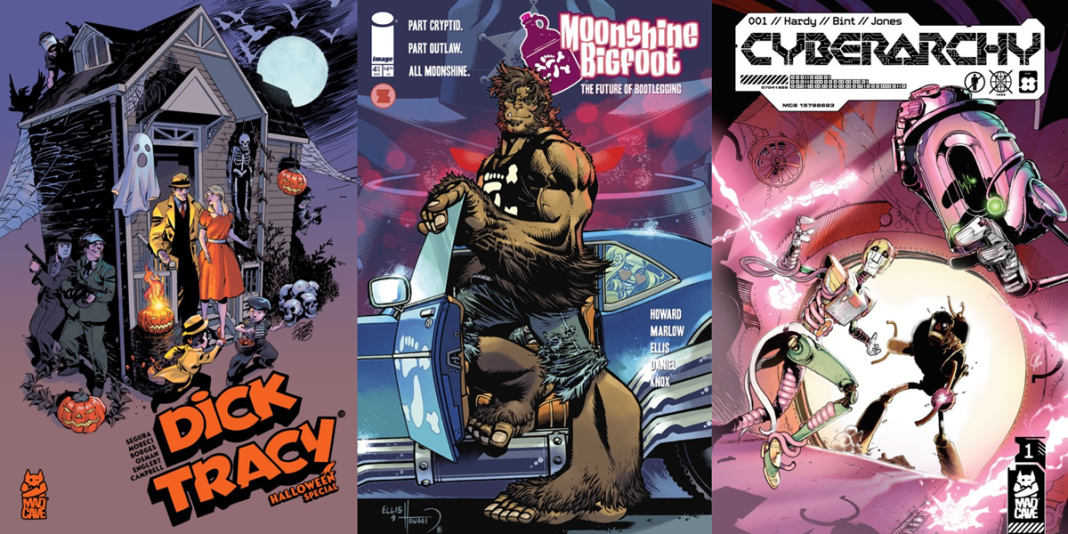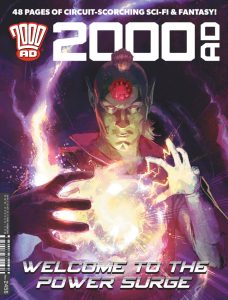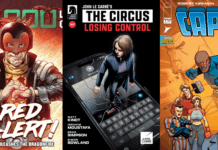In this week’s Wednesday Comics Reviews, the team reviews a Dick Tracy Halloween one-shot, a fun finale with Moonshine Bigfoot #4, and more! Plus, FOC Watch and The Prog Report!
 Dick Tracy: Halloween Special #1
Dick Tracy: Halloween Special #1
Writers: Alex Segura, Michael Moreci, Chantelle Aimée Osman
Art: Craig Cermak, Emiliana Pinna
Colors: Mark Englert, Warnia Sahadewa
Letters: Jim Campbell, Jodie Troutman
Publisher: Mad Cave Studios
Review by Clyde Hall
It’s been a quality season for Halloween themed specials this year, and the subject of my last such review is no exception. The bizarre Rogue’s Gallery of legendary lawman Dick Tracy could certainly give Batman’s Arkham foes competition in any Long Halloween marathon. And in the one-shot Dick Tracy: Halloween Special out this week, we get a cross section of Tracy’s more dangerous adversaries along with a new, fitting addition to his list of Public Enemies.
The first story concerns attacks against former criminals turned actors, carried out by various members of Tracy’s underworld foes. In fact, an oddly varied array of them given the targets and tasks at hand. The mystery ends in a satisfying revelation and a worthy addition to Tracy’s enemy’s list. More, it folds classic characters from a 1937 storyline into Mad Cave’s Tracy narrative.
It’s not a rehash approach, either, but a clever reworking which suits the spooky season like a vintage Ben Cooper costume. In their promotion for this one-shot, Mad Cave’s already announced that classic Dick Tracy character the Kid makes his debut this issue. And other elements from his initial comic strip appearance surface in the tale here, yet the writing team dug beneath surface appearances in crafting something new.
In doing so, the writers also channeled one of my favorite Halloween Guilty Pleasures film, 1980’s Fade to Black, into their storytelling mix. There are a few loose threads hanging as the curtain closes, but from the plots they’ve done on the main title previously, I expect these will be picked up and worked into the continuing Tracy tapestry.
The second story, “Witchsplaining”, is a Tess Trueheart adventure. And while Tess plays a major role in the first story, it’s great seeing her take center stage in her own tale here. Once more, some of the characters used are part of a Chester Gould story from the strips, this one a 1972 tale selected for its All Hallows’ appropriateness.
When she’s stood up by Tracy for the Mayor’s Halloween Party, Tess goes on alone. Spotting a trio of likely fellow partygoers along the way, she follows them and ends up amidst a theft ring who’s been plaguing the city for months. Perhaps inspired by the costume Tess wears for the occasion, and it’s a great one, she decides outsmarting the crooks and getting her scoop is what a crusading journalist would do.
But her timing proves perilous. Still, finding more in common with one of the gang members than she expects may help Tess overcome the danger, catch the bad guys, and file her story before her competitors. Even if it requires a little holiday magic.
While the story dialogue is a bit hard to follow in spots, its tone reflects the uncertainty facing the criminals as Tess’s plans are implemented. Confusing crooks is one skill a reporter of her caliber needs, and she shows it here. That makes for a fun yarn tapping deep into the Halloween spirit, one including themes of concealed identities from the forces of evil.
I expect some readers might bemoan a humorous reference to the TV series Bewitched as not being true to the time period of this story. Technically, they may be right. However, as the foundation of this witchy tale is a 1972 story, in an underlying way it’s perfect given the TV series’ run from 1964–1972. Anyone taking issue with it probably doesn’t believe in the Great Pumpkin, either.
Together, Alex Segura, Michael Moreci, and Chantelle Aimée Osman have found the right narrative resources and characters from past continuity that work for a Halloween celebratory issue. Then they tailored their own stories with them in mind, deftly taking their distinct approaches and creating something unique and different. They did well in the space given, well enough I’d like to have seen them get an additional 5-10 pages for fleshing out more details. Or building additional suspense.
The artwork of both Craig Cermak and Emiliana Pinna for this special continues the modernization of the classic comic strip style found in the ongoing Tracy titles at Mad Cave. The aesthetic approach there and here is one of my favorite elements in their ongoing Tracy iteration. In particular this issue, Cermak’s take on the villains in the first story is most appealing. He manages the right mix of traditional details and more modern realism, and that’s not easy when dealing with characters like Flattop. Readers also get a sketch gallery bonus of Cermak’s designs for the initial story.
Add to the mix two enjoyably creepy covers, one by Geraldo Borges, the other by Soo Lee, and the end result is a special with great appeal for Dick Tracy fans who also enjoy a smattering of skullduggery or a measure of macabre in their crimefighting.
 Moonshine Bigfoot #4
Moonshine Bigfoot #4
Writers: Mike Marlow and Zach Howard
Pencils: Steve Ellis
Inker: Zach Howard
Colorist: Nelson Daniel
Letterer and Designer: Thompson Knox
Publisher: Image Comics – Syzygy Publishing
Review by Khalid Johnson
FOC Watch
The following comic is currently available for pre-order.
 Cyberarchy #1
Cyberarchy #1
Writer: Matt Hardy
Artist: Clark Bint
Letterer: Rob Jones
Publisher: Mad Cave Studios
Due Out: Dec. 3, 2025
Review by Zack Quaintance
One of my favorite genres of comics is robot comics. It’s a generally under-explored genre, excepting something massive like Transformers, which is maybe more of a nostalgia property comic at this point than a pure robot comic. In recent comics memory, this genre has been spare but good, with Mark Russell’s and Mike Deodato’s Eisner-winning Not All Robots standing out as a highlight, along with the two arcs of The Kill Lock that Livio Ramondelli did a few years back.
Generally, how this genre works is that comic book creators use robots as a canvas for human philosophy, personalities, politics, etc., dissecting our societal issues with a robot’s unyielding sense of programming or logic, all while drawing big excellent sci-fi technology. And the latest entry to this genre, at least within monthly comics circles, is Mad Cave Studios’ forthcoming release, Cyberarchy, from the seasoned indie comics team of writer Matt Hardy, artist Clark Bint, and letterer Rob Jones.
And it’s an interesting comic. The central idea is that on a great spaceship, humans became overly-reliant on AI and robots and technology (think Wall-E), and then one day the robots decided to stop helping them…and all the humans died. It’s definitely timely stuff, as AI remains an area of much discussion and investment, with new studies already showing that overreliance on AI might not be great for human mental capacity.
What’s interesting from a comics craft perspective here is that so much of the story is told through massive, two-page spreads. Bint pulls these off over and over again in a way that gives the story a widescreen feel, yet does not sacrifice any attention to detail or intricacy (watch out, Bryan Hitch!). It’s a sharp, good-looking book, and the two-page spreads flow into each other perfectly, giving it all a rapidfire sense of pacing.
The script is also really well done, with a dry sense of humor and a third act twist that sort of recontextualizes the entire series (or so it would seem after just one issue). There’s actually a great decision to double or triple disorient the reader toward the end of this first issue with a series of quick reveals, and I really enjoyed how that was executed. The lettering is also fantastic by Rob Jones. Jones always does a great job with his work, but with all the spreads here, it falls upon him to really guide the eye with his lettering. And he absolutely nails it.
If I have a note about this book, it’s that the issue reads quickly and because of that may work better once it’s published in trade as an opening chapter of a completed story, but that’s a very small note. The artwork is actually so well done in this book, that after my first quick read, I went back into it to check out the action sequences and robot designs again.
All in all, Cyberarchy #1 is a great series debut and a top-notch robot comic.
The Prog Report
2000AD 2456 (Rebellion Publishing): This week brings us an extra-long bumper issue, the fourth and final one of those for the year, and it’s not really a jumping on point bumper issue. It is, however, a strong issue as The Prog currently finds itself within what is — in my opinion, of course — it’s best stretch of the year. The Dredd and Rogue Trooper stories are both fantastic, bookending this issue, while the ongoing interior curiosities are also quite good, from Red Dragon to Brass Sun. So, that’s a nice starting point for this bumper issue. In addition, we also get what is effectively a quick taste of the world of the forthcoming original graphic novel (with an untouchably-excellent title) Big-Ass Sword by Andreas Butzbach. And it’s a fun one. The other newness in this issue, though, is the return of Nightmare New York, a strip I enjoyed quite a bit when it first ran last year (was it last year? time is weird, but it feels like it was last year…). It’s back as Nightmare New York: Hard Times, and it’s by writer Kek-W, artist David Roach, colorist Peter Doherty, and letterer Jim Campbell. It’s a story about magic and the occult, set in Old New York, and it’s a great time. This new strip opens up too with a fun cameo appearance that I won’t spoil here. This week’s cover (above) is by Mike Dowling. As always, you can pick up a digital copy of The Prog here. —Zack Quaintance
Column edited by The Beat’s reviews editor, Zack Quaintance.
Read past entries in the weekly Wednesday Comics reviews series or check-out our other reviews here!














